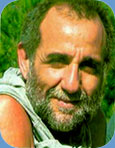|
A Meditation Course in Jail
by Dr Vincenzo Fatta
(Translated from the Italian)
"It is hard going and subtle work. Inside a structure that favors surveillance and control a message is transmitted that invites you to let go...to experiment, with total freedom, with the mental and emotional parts which comprise the personality," observes Paragyan, Dr Vincenzo Fatta, who, for some months, has lead a course in meditation and holistic therapy in the Pagliarelli Prison, Palermo. He recounts his experience....
It has taken almost a year – during which time the project (Relaxation and Purification Methods for Prisons) was presented to the City Council of Palermo and approved, discussed with the prison administration, and after many formalities approved by the judicial authorities – before we were finally able to start our work.
Now finally, I find myself in the prison theater, in front of us (my business partner and me) an audience of many prisoners, brought down from their cells, to attend the presentation of this unusual and mysterious meditation course.
During the course of my life I have found myself in the most varied and strange places to present and promote therapy and meditations. But this time the scene is surreal! Behind us, a wall of prison wardens and, in front, about one hundred prisoners detained for being members of the Mafia or having other convictions, more or less serious. Many of them wear a glazed and inscrutable expression.
I start to perceive around my solar plexus a feeling of uneasiness and a mixture of sorrow and anguish. What can I possibly say to these people? How is it possible to share something in a place in which, with all these external restrictions, people live far below their potential?
All those feelings passing through me in those very long moments of silence. The sorrow that I feel if I consider the difficulties that these people are facing in keeping an acceptable level of normality emboldens me not to give vent to powerful emotions and to start crying, but to come out with assertiveness, with the deliberately provocative, almost challenging words: "These methods are not for everybody...only for those who still feel alive and want to use this time to their advantage.... Only for those who want to discover more freedom inside...."
Facing this challenge, probably perceived by some of them as a form of compassion, suddenly the energy in the hall becomes more alive, while the silence continues, full of looks of curiosity, interest, rejection, exuberance and studied indifference.
I enlarge, going into details of the process, the creation inside of the prison of the right space to meditate – through breathing techniques, through methods to release the mental, physical and emotions tensions that all of us have and suffer from, no matter if we are in prison or not.
Now the challenge has been thrown out to them and I announce that their requests to the prison authority to participate have to have medical approval attached that confirms there are no psychiatric problems or infectious diseases. Suddenly a course for twenty participants appears too limited, as dozens of hands rise to show their existence and willingness to participate. We cannot take all these people. I feel a bit uneasy closing the doors to so many people, so I leave the hot potato to the educators, trusting in their choice of selection.
Continuing the explanation, I talk about the need to release the toxins from our organism that we accumulate in many situations –anger, sadness, and inhibitions – without necessarily having an object to direct them on. I also talk about the possibility of finding "inner freedom independent of external situations."
This is, again, provocative. In fact there is almost a hint of rebellion in many: "What? My family is out there without anything to eat, children have no milk, and with all these worries...?"
I find the courage to warn them, in spite of the sorrow I feel: "This experiment is only for those who want to change, who don't want to sleep in the mud of pessimism, distrust and laziness."
I feel more and more protected from something unknown, and not from that wall of prison wardens, without whose presence it is easy to imagine some of the most angry inmates signaling a "fuck-off" to this guy who comes in here to teach them.
But now the message is clear: "We are all in prisons – the prison of our fears, of our conditioning and our obsessions. Paradoxically, you all are in a clearer situation. The others out there – they feel free...." Even the most argumentative ones look speechless and, throughout the hall, I start to perceive a kind of transfixed attention. I feel like the will to argue is not there; it has disappeared. Everybody looks suddenly respectful, like curious schoolboys, and concentrates on reading the piece of paper distributed to them, on which the potential benefits of meditation are outlined.
We take our leave, announcing our intention of starting as soon as possible, after having all the authorization for the equipment for the meditation room, and after all the participants' requests have been approved by the doctor and prison administration. We leave the hall, saluted by vigorous handshakes that energetically seal an agreement that is starting with a risk.
As I write this, we are already half way through the course, in which there is an active participation of seventy percent of the inmates. Some of them left because they have been transferred or released, but new applicants are waiting for their authorization. We have won the right to our working space being as we want it, after some difficulties with "vigilance operators" who wanted continuous control and who were intrusive.
Now that we are autonomous and in the gym of the prison – three times a week for two hours – the message is no longer about control and repression but about let go and experimenting, leading to experiencing the wholeness and depth of being.
The wardens, looking through the peephole, confess to me that they also would like some time to have the possibility of "going crazy"! We also took the risk of being thrown out because we were too loud in Osho Dynamic but now it is all right. It's amazing – in a place where, to be able to survive, it seems necessarily to keep an iron psychological protective shield – to see that, in spite of everything, some prisoners find, in the alone spaces of meditation, the courage to open up and experiment in the subtleties and depth of their being... to come to trust in the possibility of self-redemption and a new vision of life.
In these sessions an energetic space has been created that as such does not belong to the jail but is an oasis where one feels accepted and not judged. Slowly we have come to a phase where maybe we sing Neapolitan songs or exchange jokes – a natural consequence of friendliness that makes the whole meditation course full of humor and warmth.
I don't know to what extent this experiment will contribute to improve the quality of life in prison. The inmates themselves would like to continue beyond the three months of the course and we, from our side, are certainly available to continue, if the institution wants to invest in these methods.
I appreciate the active meditations as one more tool in the re-education field. Certainly this is for me a great opportunity to learn, and also to feel centered and "protected" in the most apparently difficult situation.
In reality, inside or outside the prison, the situation is basically the same: with meditation you can discover, as my beloved master Osho teaches, that inside we are already free (if we want to be).
Read more about Dr Fatta's work in:
...Doing Time as a Meditation
...The Inside Story: Prisoners' Feedback
...Prison: A Lesson in Inner Freedom - La Republica
...Back for more
Copyright© Osho Times International
|
|


